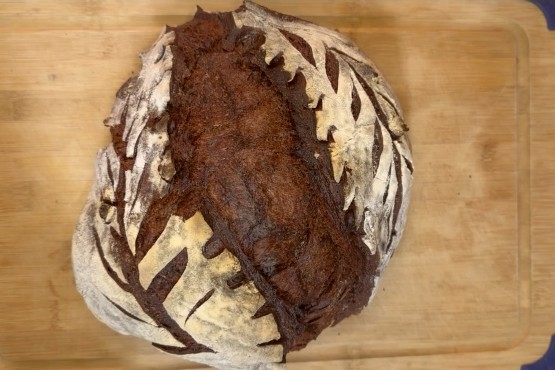Double Chocolate Sourdough Bread
1 Loaf
90 min
1 h
15 h
17 h 30 min
Ingredients
Chocolate starter:
- 30 g sourdough starter
- 60 g water
- 30 g all-purpose flour
- 30 g cocoa
Main dough:
- 600 g bread flour
- 480 g black coffee (80% hydration)
- 150 g chocolate starter (25%)
- 60 g cocoa (10%)
- 72 coconut sugar (12%)
- 12 g salt (2%)
- 6 g vanilla extract (1%)
- 120 g dark chocolate chips
Equipment
- Bowl
- Danish Whisk
- Scale
- Dough Scraper
- Spatula
- Plastic Wrap/Tea Towel
- Cast Iron Dutch Oven
- Razor Blade/Blade Lame
- Proofing Basket
- Baking Sheet
- Cooling Rack
- Parchment Paper/Silicone Baking Mat
- Bread Knife
- Oven Mitts
Instructions

 (Show/Hide Images In The Recipe)
(Show/Hide Images In The Recipe)
Chocolate starter:
1. Mix all the ingredients and let it sit at room temperature until it doubles in volume, and looks active and bubbly.
Sourdough starter is ready to use when it floats in water.
30 g sourdough starter
60 g water
30 g all-purpose flour
30 g cocoa
Main dough:
1. In a bowl, combine wet ingredients. Mix until well combined.
480 g black coffee (80% hydration)
6 g vanilla extract (1%)
150 g chocolate starter (25%)
2. Add dry ingredients to the wet mix and mix until well incorporated. Cover the bowl with plastic wrap or a tea towel. Let it rest for 30 minutes.
600 g bread flour
60 g cocoa (10%)
72 coconut sugar (12%)
12 g salt (2%)
3. Add the chocolate chips and during the next 2 hours, every 30 minutes stretch and fold* the dough, to make a total of 4 stretches and folds. (The chocolate chips will be integrated as the dough is folded.)
Stretch and Fold*: Gently lift one side of the dough and fold it towards the center. Repeat this process for the remaining three sides of the dough. This method essentially turns the dough inside out.
4. *Bulk Fermentation: After completing the last stretch and fold, cover the bowl, and leave it in a warm place until it doubles in size, it could go from 4 to 12 hours depending on the room temperature. For me, it took 10 hours at room temp 65°F/18°C.
Bulk fermentation* is the initial stage of dough fermentation after mixing the dough. It is also known as the "first rise" or ”primary fermentation”. It begins immediately after mixing and ends when the dough is shaped. It is typically the longest step in the sourdough process.
5. Place the dough on a clean surface, and shape it into a boule. (Use a little flour if the dough sticks.)
6. Prepare banneton with flour or a cloth liner to prevent the dough from sticking.
7. Proofing*: Once the dough is shaped, place it in a banneton, cover it and let it proof for 2-4 hours at room temperature or overnight in the fridge. This time, I left the dough proof for 1 hour at room temp 70°F/21°C and 2 hours in the fridge.
Poke Test: The dough will be fully proofed when you poke it and it springs back just a little. (If it springs back immediately, the dough is underproofed; if the dough never springs back, it means it's overproofed)
Proofing* is when the dough is allowed to rise and develop flavor, after shaping but before baking. It is also known as the "second rise" or “final fermentation”.
8. Preheat the oven and the Dutch oven to 450°F / 230°C for at least 30 minutes.
9. Place the dough on a silicon mat/parchment paper. Score the top of the dough with a razor or a sharp knife. The scoring helps the bread to rise evenly and prevents it from cracking.
10. Bake the bread with the lid on for 35 minutes.
11. Remove the lid and bake for 15 more minutes.
12. Remove the bread from the oven and let it cool on a wire rack for at least 1 hour before slicing and serving.
Enjoy!
Tips:
- Prevent the bottom of your bread from burning by adding a layer of cornmeal to the bottom of the Dutch oven or using 2 silicone mats when baking your bread.
- Store it in a container or resealable bag at room temperature for up to 5 days or freeze them for up to 3 months.
















